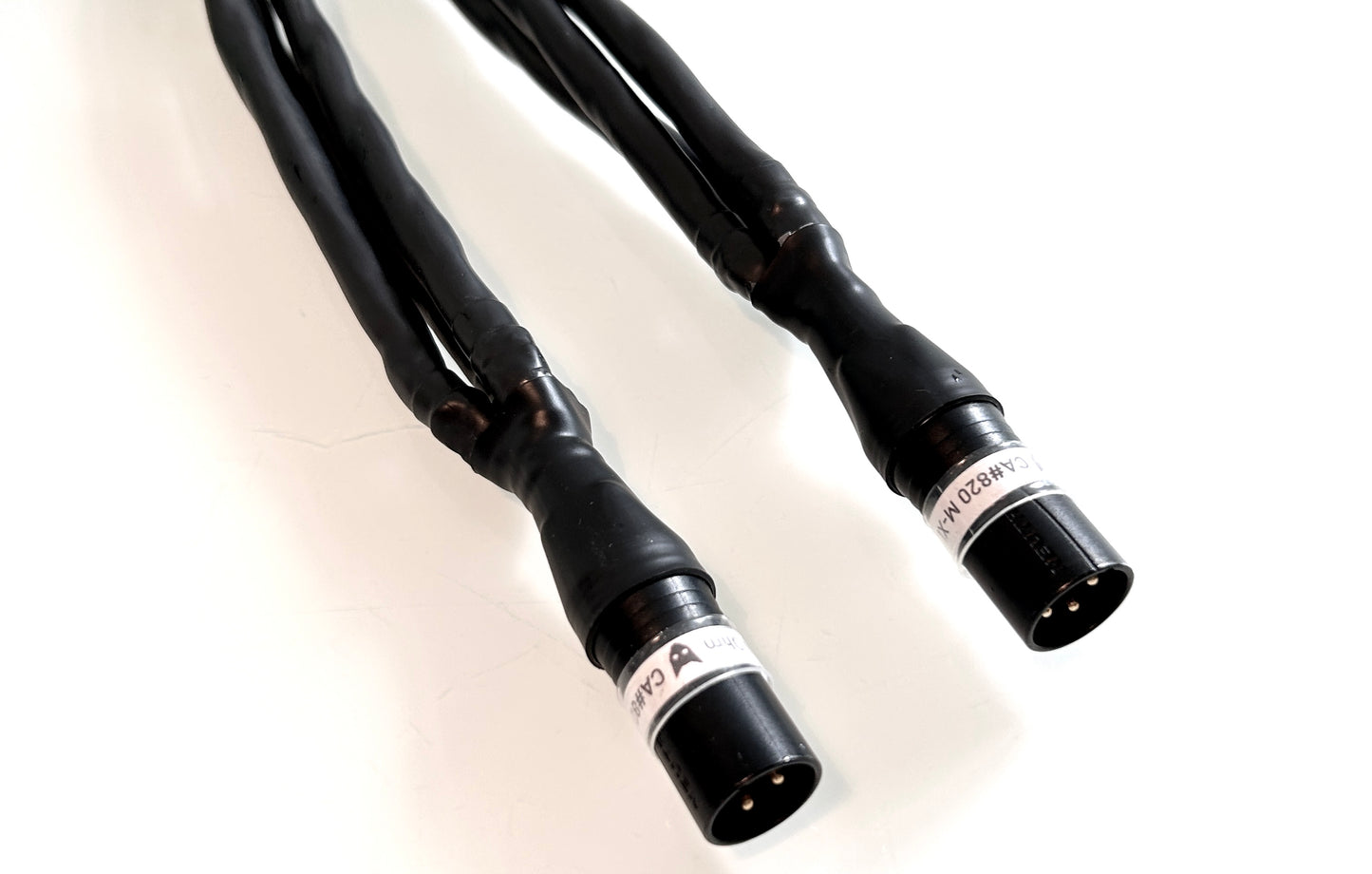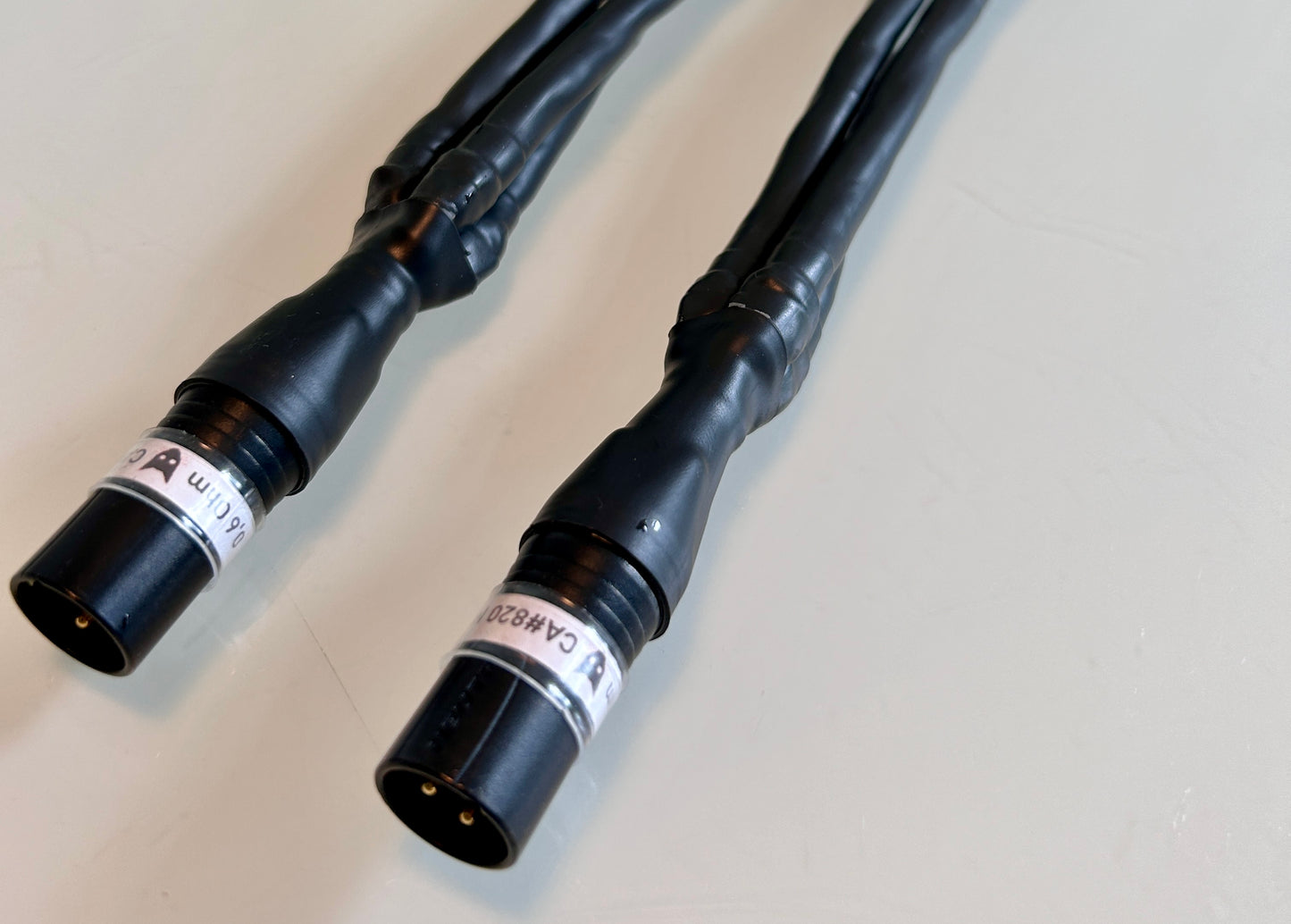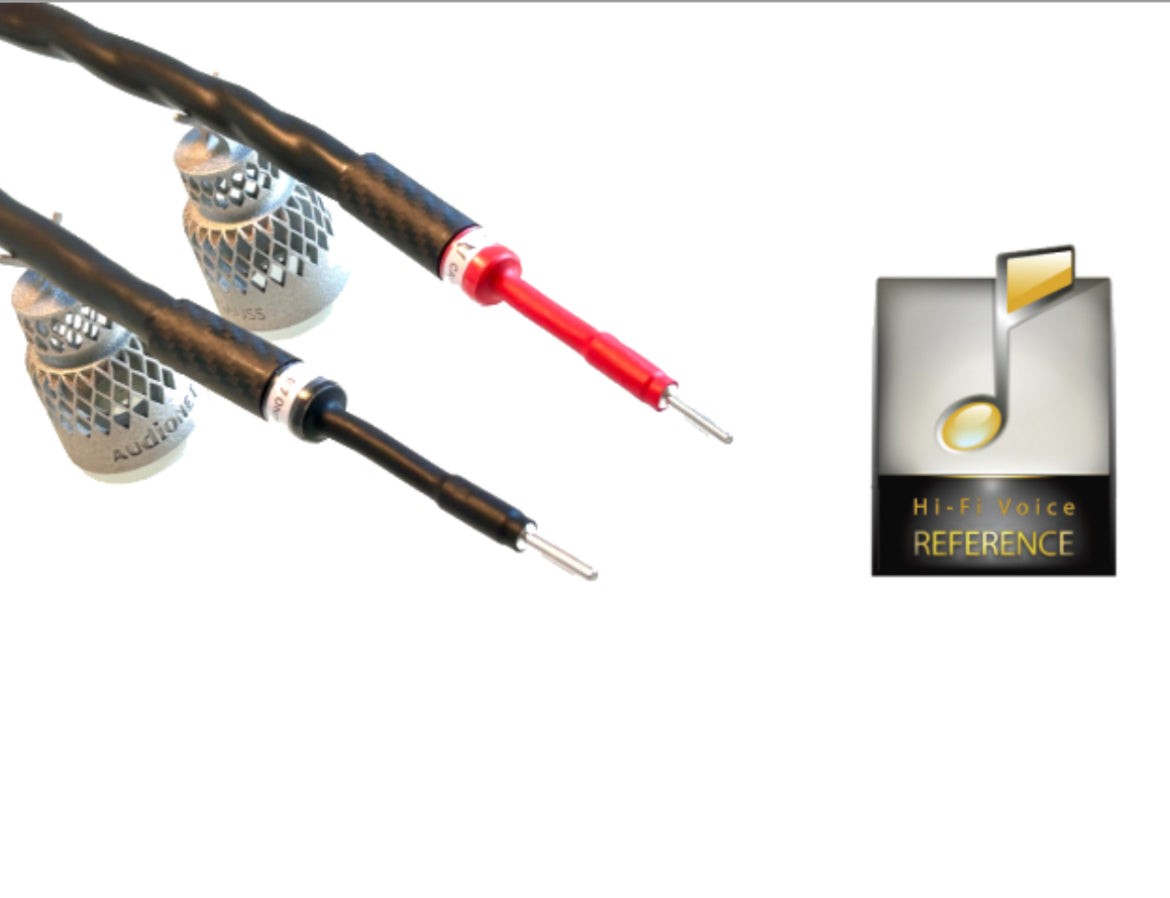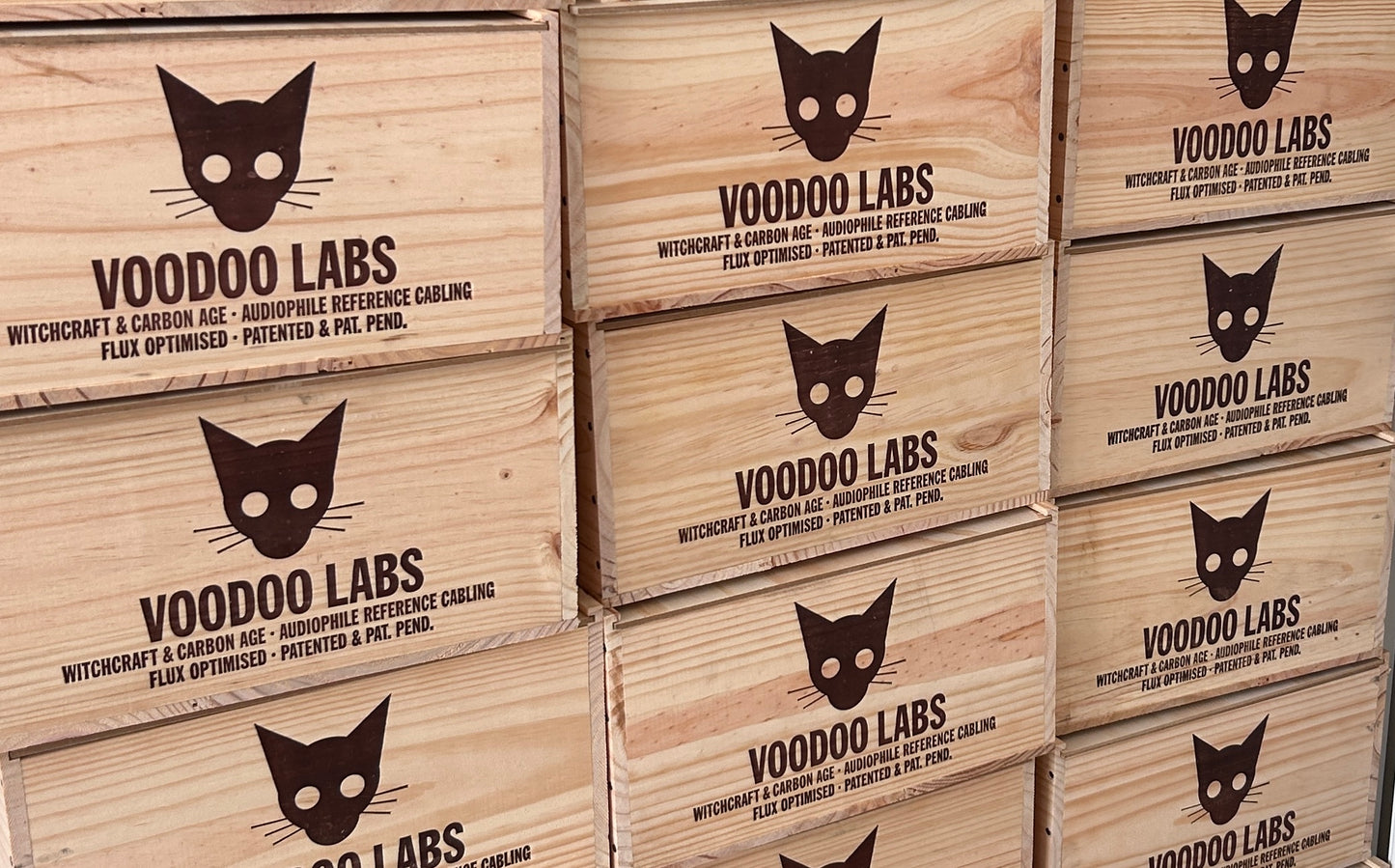Voodoo Labs High End Reference Cabling
VL CARBON AGE™ MASTER balanced XLR 80cm
VL CARBON AGE™ MASTER balanced XLR 80cm
Couldn't load pickup availability
CARBON AGE MASTER balanced XLR
(patented by the German Patentamt as patent DE 10 2023 005 191)
The brand new MASTER version of our highly sought after unique pure carbon cable. With more than a million conductors for each of the physically separated strands is sets a breathtaking new standard for totally natural unimpeded lightspeed signal propagation. Owners of the world‘s best set-ups agree, this is THE cable to dream of.
Goosebump moments thanks to a patented new interconnector - the beguilingly free and clean-sounding new „wonder cable“ (HiFi Sound&Music) from cult high-end manufacturer Voodoo Labs. “Perfect beauty” (J.Pfeiffer, HiFi Sound&Music, 2024). "It was simply better, sounded more like the character of the amplifier and the speakers, or the signal source, somehow more intense and much, much clearer." (Daniel Brezina, HiFi-Voice, 2024)
Pair 0.80m 11.400€ per individual license
Available in studio black. For studio lengths give us a call or mail.
Free of the inductivity and capacitance problems of the usual Coax balanced cables. Created as unique pieces by master craftsmen in Northern Germany. They easily reach and exceed the level of the most renowned high-end cables, this also applies to the price. Unique signal quality, incredibly fast and tonally correct with optimal aging resistance. One for the island, between sources and pre-amp as well as between pre- and power amp. Ideal for CD players, streamers, amplifiers. Due to the (relatively) minuscule resistance following our patent-pending approach even perfect for phono pre to amp connections. Trust us, we’re running these ourselves in the studio.
- singular for a balanced cable: physically separated phases
- highest quality pure, shielding-free carbon construction
- completely metal-free except for the termination
- approx. 1 Mio. carbon nano tubes per individual cable
- 4 valence electrons in the atomic outer shells for perfect signal propagation
- tin-plated connection with silver solder to the pro-grade XLR terminator
- minimal internal resistance
- completely hand-crafted in Northern Germany
The bespoke cables are individually handmade.
Delivery time is currently approx. 5 days.
Unless otherwise instructed, your CARBON AGE will be delivered in a fine wooden wine crate made from NIMP 15 certified pine wood from sustainable forestation by the Bordeaux casemaker working for Chateau Petrus as well. Great for storing Jazz records in, too.
More information and special lengths on request: info@voodoolabs.org or +4940485535
read the newest review in Hifi Choice:
We can’t read this often enough. Must be the nicest review ever. Must be because Daniel is a really nice guy. Could be our stuff ain’t that bad either.
Voodoo Labs Carbon Age MASTER
The Hamburg-based original cable manufactory Voodoo Labs, founded by Jan Hendrik Geschke (by profession an expert in the field of authenticity assessment of the most expensive paintings of the old masters, "on the side" for some 30 years marketing and sound consultant of brands from Dynaudio, through Burmester to Peak Consult to name a few), is experiencing a rather meteoric rise in the world and is expanding its portfolio at a rather brisk pace. From the original Witchcraft speaker cables, through the Carbon Age series, it has now made its way up to versions with the MASTER moniker, essentially representing a doubling of each model for a 20% premium.
Let's remind ourselves why the Voodoo Labs brand, with its patented solutions, is basically in total opposition to perhaps every cable manufacturer in the world.
The basic goal of Voodoo Labs cabling is to achieve the lowest internal resistance and the easiest possible signal transfer. For example, the Witchcraft MASTER series cables have a resistance value of 0.002 ohm / 2 m, whereas (the manufacturer itself states this comparison) an AudioQuest Type 3 has 0.04 ohm at the same length. This is 20 times more...
The other major difference is that J.H. Geschke understands the signal not as a "stream of electrons" inside the wire, as many imagine, but physically and meaningfully justifies in his comments that it is actually a flowing electromagnetic field AROUND the wires. This then of course must very significantly affect the design principles of transmission paths, because - according to his philosophy - what's the point of all those thick wires, insulation and who knows what, if the signal we want to worry about is not in them.
The manufacturer says the term "electric current" is a late 19th century simplification, when engineers of the day made life easier by equating it with water current. Geschke defines (among deliberately humorous, even mystifying formulations) the phenomenon as "the rate of flow of electric charge in an electric field", i.e. no "flowing electrons". Electric charge then travels realistically at the speed of light. About 95% of the musical signal, according to Voodoo Labs, is contained in this electromagnetic field around the wires. Specifically in the air dielectric around. The remaining 5% is then supposed to travel through the top skin of the cables. 100 Hz at max. 6 mm depth, 10,000 Hz at 0.6 mm, etc. In the spirit of this, it supposedly makes no sense to have thick cabling.
Therefore, the company further builds on the idea that the cables must be in the air, just as high voltage long distance power lines are. For example, the floor is supposed to add its capacitance to that of the cable and "suck the life out of the music" as JHG puts it.
It is for the above reasons that the Carbon Age series uses about a million (the number depends on the specific model) carbon nanotubes as a "bad" conductor, but one that, Geschke says, makes it all the better and faster at transmitting electromagnetic fields, or charge. His supporting argument is, for example, that a signal in a vacuum travels millions and billions of kilometres without being affected, and that vacuum is a really lousy conductor.
If we go even deeper into Mr Geschke's very original point of view, we find ourselves truly going down the rabbit hole. Or not, because everything is said to be based on Maxwell's equation for the definition of field velocity, permittivity and permeability from 1865 - v = c/√(μr x Σr) and Einstein's unified field theory. Carbon Age cables are said to have an electromagnetic field several centimetres wide around them, so you should in any case support them with adequately high pedestals and not let them touch any materials, especially wood and magnetic alloys.
The carbon wires in Carbon Age are exposed to X-rays, although the manufacturer does not specify what it does to them. In keeping with his more challenging sense of humour, he says he is performing black magic. To add to the Witchcraft cables, they use thin copper fibres in a tin casing, which is said to behave similarly to carbon. They are together in the same group of elements and have a quartet of valence electrons (which are said to be the ones through which the crucial electromagnetic field is supposed to travel).
Carbon Age MASTER - speaker cable
The construction consists of fully separated positive and negative branches, an unspecified twist can be seen underneath the wrapper, and the cable is terminated with a tube handmade from pure carbon. You can choose from both spades and bananas. Although the wiring looks a lot better crafted than the first samples, it still doesn't pay any attention to the outer skin at all - it's a purposeful, practical wire that's actually good to work with thanks to its reasonable stiffness. You can choose from a black, grey or white finish. Inside each of the larger ones are over a million carbon nanotubes. They don't use any shielding materials, the only metal is in the connector contacts - these are tinned OFC copper, fixed with silver solder, and the connectors themselves are silver plated.
Carbon Age MASTER - RCA signal cable
The signal cable is also split into two independent branches for most of its journey (we're talking one channel), meeting just before the cinch termination. Here too, there are visible "scoops" of twists inside the package, the million carbon nanotubes are also unshielded - the manufacturer says that airborne electromagnetic and radio frequency interference never had any effect during development.
Carbon Age MASTER speaker bridges
An interesting solution is speaker bi-wiring bridges. They look a bit like Christmas rolls, but in a larger format. These are not just shortened speaker cables. The bananas are flexible types, gilded, and inside they follow the concept of the Carbon Age MASTER series in technology and materials.
Witchcraft MASTER - RCA signal cable
As part of the test set, the manufacturer also sent one Witchcraft MASTER interconnect cable, as it is said to be great combination. The cinch cable looks very much like a smaller version of the speaker one. The simple gold-plated connectors are followed by an oiled cotton braid equipped with eight independent wires, which are kept at the right distance from each other by grids printed on a special printer from a special alloy. The grids are smaller than those of a speaker cable, but can also be fitted into the company's racks. These too are from the AlMgty90 material, cured at 500 degrees Celsius. The individual wires are made of thin oxygen-free copper with a tin coating.
We compared the cables to our "working mix" - i.e. Nordost Valhalla 2, Nordost Heimdall 2 and KrautWire Super Symetric. We also had a chance to test the TelluriumQ Silver Diamond speaker cable for a while. We listened to Métronome DSC, Norma Revo SC-2 LN and Norma Revo PA 160 MR through KEF Blade One Meta. See the right-hand column --> to learn about other accessories and accessories.
Most cabling more or less fine-tunes the sound characteristics of the system, changing it and adding their own style to it. But Carbon Age MASTER seems to have emphasized the fundamental characteristics of electronics and loudspeakers, letting them blossom and sound - we can't think of a better word - freer.
The Nordic "Glem ikkje" by Kari Bremnes ("Det vi har" | 2017 | Strange Ways | WAY 309) has a dark electronic rhythm, and with Carbon Age MASTER cabling, we felt the most density, depth, and self-consciousness to date. It's malleable, supple, amazingly powerful yet relaxed. The sound flowed with an almost honeyed warmth and fluidity, characteristics defined by the Métronome streamer and the slightly darker KEFs. The cables themselves seemed to 'unblock' things, as if an obstacle had disappeared from the path and the music throbbed in a completely non-technical and uncluttered manner. The ease is fascinating.
Also in "Feeling Like Myself" (Roses & Revolutions | "Midnight Monsters" | 2021) there was a change and a feeling that we have never heard it like this on a main setup. The recording opened up, or rather got bigger and airier. It's a hard transformation to describe - one would like to say that everything was suddenly „more“, every single aspect. The performance is unbridled and breathing, powerful, rich and even the relatively average sound quality seems to have improved. The listening experience is downright caressing and seems "analogue", subtle yet vividly energetic.
Even the cut of the cymbals in "Beauty Queen" (Roxy Music | "For Your Pleasure" | 1999 | recorded 1973 | EG | 0724384744922) was simply calmer, more natural - clearer, yet somehow smoother with the Carbon Age MASTER. But along with that, the delicate metallic sounds also have more detail, or seem more distinct and better defined, more concrete. It's such a transformation that you can stop worrying about everything and just enjoy the organic, natural sound.
Debussy's lively string "Assez vif et bien rhytmé" (Carmina Quartet | "String Quartet, Op. 10" | 1992 | Denon | CO-75164) sounded with Carbon Age MASTER with a more expressive intensity, without any attempt to impress with effects or ostentatious power. The power of the instruments is presented with amazing naturalness, freedom and ease. Technique seems to recede completely into the background and only the musical component remains, present, rich and truly full-blooded. That being said - to engage Carbon Age MASTER is to get "more of everything". The dynamics are somehow "live", authentic and impressive, and the speakers sing really surprisingly well.
It cannot be said that Carbon Age MASTER emphasized the sound or brought out the details in any way, and yet - the subtle shades and reverberations of Julia Fischer's violin in "No. 1 in E major" ("Paganini: 24 Caprices" | 2010 | Decca | 0028947822745) were set in a giant canvas of air, that hard-to-capture-in-words impression that it is not just the individual sounds that are in front of you, but the complex space in which the instrument is playing. Everything is perfectly organic, unforced and uncomplicated, the cables seeming to remove the last vestiges of the feeling of the mechanical. It's fascinating how the reproduction actually feels more relaxed and grown-up, with considerably more insight and substance, although realistically neither the sense of frequency balance nor timbre changes - simply the individual „voice“ of components of the set-up become more apparent.
Interestingly, Carbon Age MASTER's presence (or rather, sonic NON-presence) in the chain also made the "Indigo Dreamscapes" music scene (Jack DeJohnette / Pat Metheny / Herbie Hancock / Dave Holland | "Parallel Realities Live..." | 1993 | Jazz Door | JD 1251/52) bigger. All the axes have been stretched, some sounds are further behind the speakers than before, even some were closer to the listening position, which is very rare for us. Everything straddles in an impressive and natural-looking 3D image that is wonderfully non-technical. It's beautifully legible, utterly at ease.
What was also amazing was how any music played more at ease, completely unhurried, yet with plenty of life. "The Logical Song" (Supertramp | "Breakfast in America" | 2010 | recorded 1979 | A&M | 0600753304372) can seem too intense at higher volumes. But not with Carbon Age MASTER - the last hint of any unpleasantness was gone, but the music itself stood out all the more, rich, meaty, fluid and rhythmic. Like when a setup brings out the best of itself, the maximum of musicality and lilting, it's great fun.
The Voodoo Labs cabling concept, hand in hand with the somewhat ironic self-presentation style of its maker, creates an irritating mix of "too different" for many, but it has to be said that it sonically works for some reason. The Carbon Age MASTER series is quite expensive, no question about it, but instead of the shiny ornate and impressive exterior there is something far more interesting. After plugging them in, the sound "got bolder" - it got bigger, fuller, calmer, and gained in every attribute from clarity to dynamics. And all of this in a completely calm and cool way. We were amazed at how powerfully the "mere cables" were able to transform our main lineup, how they managed to emphasize the essential DNA of the speakers, amplifiers and signal source, while the musical performances unfolded with analog smoothness, fluidity and accentuated musicality. If you want to hear "more" of your music and "more" of your components, then - if you have an adequate setup and budget - the Voodoo Labs Carbon Age MASTERs are amazing, fascinating cables.
--- --- --- --- ---
PROS
+ much better build than ever before
+ fascinating feeling of "freedom" in all aspects
+ flexibility of design and easy handling
+ very transparent feeling
+ shows the "real face" of your recordings and components
+ supports musicality
CONS
- prices are really on the premium side
--- --- --- --- ---
MANUFACTURER: Voodoo Labs | www.voodoolabs.org
on my iphone
—
–
Read legendary (of Audio and Hifi Sound&Music fame) editor-in-chief Jo Pfeiffer‘s first short review, long version to be published shortly:
US DER REDAKTION – NF Connector Voodoo Labs "Carbon Age RCA"
It's an old story that in the world of High Fidelity, new developments constantly emerge aiming to reveal the finest acoustic nuances. Experienced engineers and developers work on it, as well as some supposed eccentrics. My esteemed "mentor" in the journalistic High-Fi realm, Hannes Scholten, founder of Audio (and Video as well as the German stereoplay magazine), once wrote an editorial titled "Take the Eccentrics Seriously." This saying stuck with me, as some seemingly crazy ideas eventually proved to be quite valid. So, before the audiophile community collectively holds its breath, I'd like to emphasize that for a few weeks now, I've been dealing with a new small-signal connector - an NF cable that connects devices like phono stages, D/A converters, CD players, and others to a full or preamplifier, and the latter also gladly to a power amplifier. This cable, called "Carbon Age," is made entirely of the finest carbon strands, allegedly over 600,000 of them. The basic idea is certainly not new. Aalt Jouk van den Hul was probably the first to use carbon as a conductor material for HiFi applications (at least to my knowledge). His first "The First" cable was actually made entirely of carbon, but later van den Hul used metal in so-called hybrid creations for unspecified reasons.
The "Carbon Age," however, dispenses with that. How exactly this works and why no unwanted side effects occurred in all test setups remains top secret for now. However, the extremely low resistance value of the "Carbon Age" of (for carbon!) extremely low 0.63 ohms is indeed no secret. At least not until the patent for Carbon Age is granted. It's already applied for.
It follows the recently tested "Witchcraft" speaker cable/"grid" from the same North German/Danish forge, Voodoo Labs, whose internal resistance is on the edge of measurability.
The acoustic advantage that Carbon Age offers can be outstanding; at least my experiences in my test cases were extremely positive. Personally, I greatly appreciate high-quality streaming, as offered, for example, through Qobuz. In my audio chain, the fantastic Grimm MU 1 receives the digital signal and forwards it for further processing to the digital/analog converter SPL Mercury. The connections to the preamplifier or to the power amplifier are then made using very high-quality cables such as the Fadel Art Coherence or Nobel cables from Audioquest and Co. The result fascinates me every time anew. I really like streaming, but I love playing records. With the Carbon Age between the phono stage (currently SPL Phonos, as will be reported in the next print magazine) and the preamplifier, for example, the Cello Audio Suite or a power amplifier like the Symphonic Line "La Musica Edition," the highly praised analog chain surpasses the digital streaming branch of my configuration. This repeatedly gives me goosebump moments as an old hand when instruments and voices detach themselves from the speakers even at low volume and this small, so uplifting step towards more authenticity promises. However, when I switch to Grimm and Co., the result is great but not so emotionally touching. If I exchange the Carbon Age for a high-quality copper-based connection between the phono stage and the preamp, analog and digital playback get closer: the performance is superb even without Carbon Age, but the big magic unfortunately disappears. In return, the Grimm/SPL combo gains when the Carbon miracle (in this case with a high-quality adapter from XLR to RCA in the signal path) plays its audiophile trumps.
Between preamp and power amp, I wouldn't want to do without CA RCA anyway. Here, the second test specimen has found its ultra-red place of use. If I remove it from the chain, I almost feel like I'm robbing the music of its soul. When Simon Ghraichy plays his Fazioli grand piano on the album "33," I not only recognize the instrument but also the intention of the performer. A single note, a struck string reveals perfect beauty.
Conclusion: The Carbon Age effortlessly reaches the level of the most renowned high-fidelity cables, but unfortunately, the price of the connection also reflects that. Nevertheless, or precisely because of that, I personally stand behind this new development, which, due to the extreme aging resistance of carbon without oxidation effects, in my opinion, will also not make any age-related compromises in quality in the long term.
Share






















